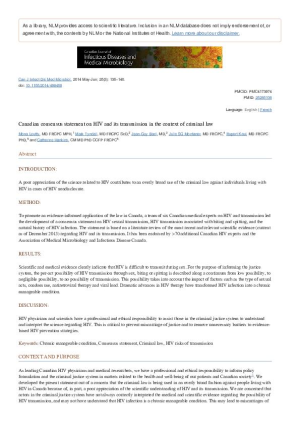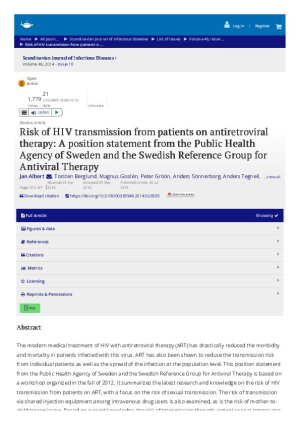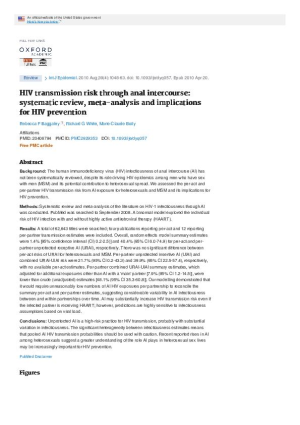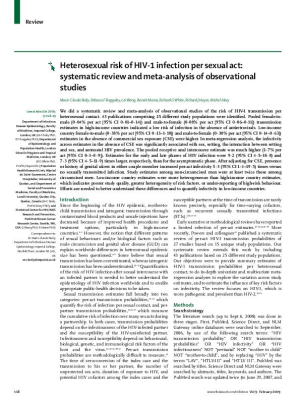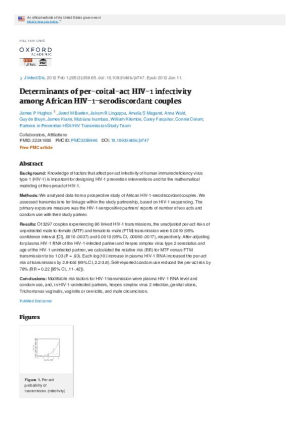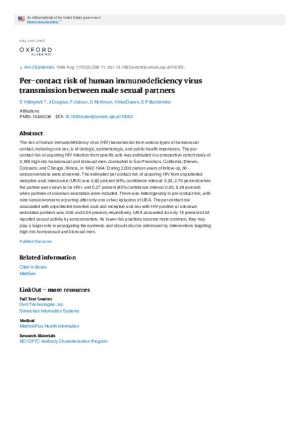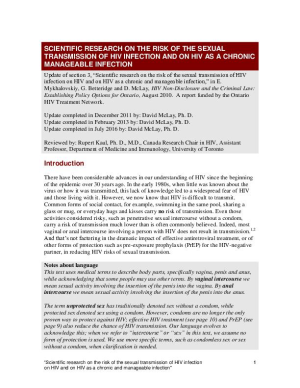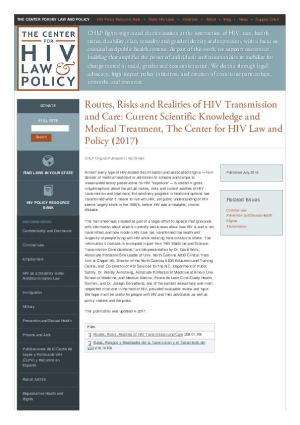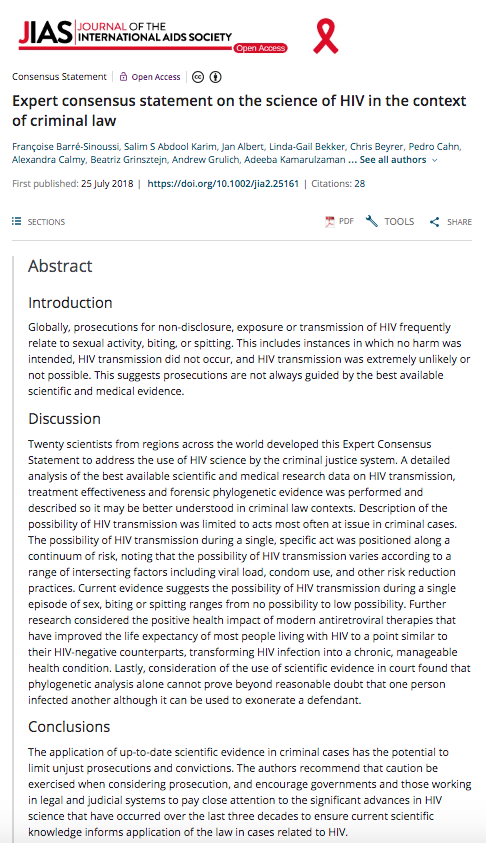Provides current scientific evidence to facilitate just outcomes in Australian criminal cases involving HIV. Argues that careful attention should be paid to the best scientific evidence on HIV risk and harms, with consideration of alternatives to prosecution, including public health management. Authored by leading Australian HIV clinicians and scientists.
Using science to prove your argument
Transmission – overview
HIV can only be transmitted in specific circumstances. Contrary to many people’s ideas, HIV is not particularly easy to transmit. This section contains scientific evidence about the risk of HIV transmission during sex. It shows that many sexual acts include only a low risk or no risk of HIV transmission. Even ‘high risk’ sexual acts do not automatically transmit HIV.
Note: Care should be taken when using these articles to ensure that information has not been superseded by a more recent study. It is also important to know that many of the early studies contained below continued to be relied on as the most accurate study on particular issues.
Canadian Consensus Statement on HIV and its transmission in the context of the criminal law
Sets out in clear, concise, and understandable terms a collective expert opinion about HIV sexual transmission, transmission associated with biting and spitting, and HIV as a chronic manageable condition. Authored by six distinguished Canadian HIV clinicians and scientists.
- Alternative links
- French
Risk of HIV transmission from patients on antiretroviral therapy: a position statement from the Public Health Agency of Sweden and the Swedish Reference Group for Antiviral Therapy
Summarises the latest research on the risk of HIV transmission from people on suppressive treatment, focusing on risk of sexual transmission. Authored by the Public Health Agency of Sweden and the Swedish Reference Group for Antiviral Therapy.
HIV transmission risk through anal intercourse: systematic review, meta-analysis and implications for HIV preventions
Reports findings from systematic review and meta-analysis of the literature on HIV-1 infectiousness through anal intercourse.
Heterosexual risk of HIV-1 infection per sexual act: systematic review and meta-analysis of observational studies
Reports findings from systematic review and meta-analysis of observational studies of the risk of HIV-1 transmission per heterosexual contact (43 publications based on 25 studies).
Determinants of Per-Coital-Act HIV-1 Infectivity Among African HIV-1–Serodiscordant Couples
Reports data from a prospective study of African HIV-1–serodiscordant couples assessing transmissions for linkage within the study partnership, based on HIV-1 sequencing. Modifiable risk factors were (HIV-positive partner) RNA level and condom use, and (HIV-negative partner) presence of STIs and male circumcision.
Per-contact probability of HIV transmission in homosexual men in Sydney in the era of HAART
Reports data from a longitudinal cohort study of community-based HIV-negative homosexual men in Sydney, Australia. Reports risk of infection through unprotected anal intercourse.
Estimating per-act HIV transmission risk: a systematic review
Reports analysis of recent studies on per-act HIV transmission risk and modifying factors. Includes risk associated with blood transfusion, vertical exposure, sexual exposures, and parenteral exposures. Finds the risk of HIV acquisition varied widely, with risk from sexual transmission substantially reduced by combined use of condoms and antiretroviral treatment of HIV-infected partners.
Per-contact risk of human immunodeficiency virus transmission between male sexual partners
Reports on follow up from prospective cohort study of gay and bisexual men. Findings include estimates of risk from unprotected anal intercourse and oral sex.
Scientific research on the risk of the sexual transmission of HIV infection and on HIV as a chronic manageable infection
Explains HIV transmission risk with reference to numerous studies, including a chart summarising per-act risk estimates for transmission of HIV during different types of sexual intercourse.
(update of original chapter in E. Mykhalovskiy, G. Betteridge and D. McLay, HIV Non-Disclosure and the Criminal Law: Establishing Policy Options for Ontario)
High rates of forward transmission events after acute/early HIV-1 infection
Uses a population-based phylogenetic approach to characterize HIV transmission dynamics in Quebec. Found early infection accounts for approximately half of onward transmissions. Suggests therapy at early stages of disease may prevent onward HIV transmission.
Sexual activity without condoms and risk of HIV transmission in serodifferent couples when the HIV-positive partner is using suppressive antiretroviral therapy
Reports findings of European prospective, observational (PARTNER) study to evaluate the rate of within-couple HIV transmission (heterosexual and men who have sex with men) during periods of sex without condoms when the HIV-positive partner had HIV-1 RNA load less than 200 copies/mL. Found no transmission after 1.3 years.
Routes, Risks and Realities of HIV Transmission and Care: Current Scientific Knowledge and Medical Treatment
This factsheet from the Center for HIV & Law Policy, published in 2017, outlines HIV transmission risk (based on “HIV Medicine and Science: Transmission Considerations”).
- Alternative links
- Spanish / Español
Expert consensus statement on the science of HIV in the context of criminal law
Twenty scientists from regions across the world developed this Expert Consensus Statement to address the use of HIV science by the criminal justice system. Description of the possibility of HIV transmission was limited to acts most often at issue in criminal cases. The authors recommend that caution be exercised when considering prosecution, and encourage governments and those working in legal and judicial systems to pay close attention to the significant advances in HIV science that have occurred over the last three decades to ensure current scientific knowledge informs application of the law in cases related to HIV.
- Alternative links
- Czech: Expertní prohlášení k vědeckým poznatkům o HIV v kontextu trestního práva , French: Déclaration de consensus d'experts sur la connaissance scientifique relative au VIH dans le contexte du droit pénal, German: Expertenkonsens zur HIV-Wissenschaft im Kontext des Strafrechts, Mandarin: 專家共識聲明:刑法脈絡下的愛滋相關科學, Russian: Заявление об экспертном консенсусе в отношении научных данных о ВИЧ- инфекции в контексте уголовного права , Spanish: Declaración de Consenso de expertos sobre la ciencia relativa al VIH en el contexto del derecho penal
Using Science for Justice: The Implications of the Expert Consensus Statement on Zimbabwe’s HIV Criminalisation Law
The article finds that, if applied by lawyers, prosecutors and courts, the Expert Consensus Statement may alleviate some unjust prosecutions and convictions in guiding courts to assess evidence on HIV transmission, to draw appropriate inferences on mental elements of the offence, to recognise defences on the basis of transmission risk-reducing conduct, and to more appropriately inform the courts’ assessment of the harm of HIV infection in sentencing. The implications of the science reflected in the Expert Consensus Statement may also weigh in favour of a finding by the courts that the offence is unconstitutional if a new constitutional case is made against the offence.
The Weight of Science: Decriminalizing HIV in Pennsylvania
This report highlights the issue of HIV criminalization in Pennsylvania, where individuals living with HIV have been prosecuted under existing criminal laws solely due to their HIV status. The report emphasizes that following the evidence-based science and moving away from fear-based approaches will be essential in addressing HIV criminalization, ending stigma and discrimination, and ultimately halting the HIV epidemic.


